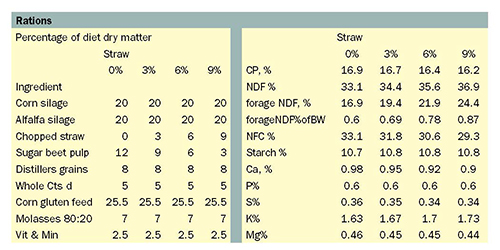For anyone who tracks the dairy industry, it's no secret that feed prices have left many producers in dire straits. "There is less forage available, feed prices are high, and low-forage diets that are high in byproducts have not been well-explored," noted Mary Beth Hall, U.S. Dairy Forage Research Center, at both the 4-State Dairy Nutrition and Management Conference and Joint Annual Meeting of the Dairy and Animal Science Societies.
To further explore what options producers have to feed less traditional low-forage, high-byproduct diets, Hall and Larry Chase, Cornell University, ran trials with rations that did not include corn or soybean meal. In place of these two feedstuffs, chopped wheat straw and pelleted sugar beet pulp were included in the diet (below).

For the trial, 48 cows in late lactation (average of 280 days in milk) spent two weeks on their herd TMR and then were transitioned to experimental rations for a four-week period. The herd diet was 61 percent forage, while the experimental rations ran closer to 40 percent forage. Seven percent molasses was also included to prevent cows from sorting.
"Neutral detergent fiber levels rose and nonfiber carbohydrate levels dropped with wheat straw inclusion. Starch levels were quite low at 11 percent compared to the regular diet at 28 percent. There was also a concern with the phosphorous levels seen on the high byproduct diets," noted Hall.
As straw levels rose, the time spent ruminating and eating both rose. From 0 to 4 hours postfeeding, there was no pH change. "There was not any material to ferment to any great extent immediately after feeding, which may account for the pH stability," noted Hall. As wheat straw inclusion rose, rumen pH levels did, as well.
With higher straw diets, there was a linear decrease in dry matter intake and pounds of milk produced. There was no impact on 3.5 percent fat and protein-corrected milk as straw levels rose. Milk urea nitrogen levels were positively correlated with wheat straw inclusion. "At 9 percent straw in the diet, milkfat was at 4.53 percent, which could indicate potential energy concerns," noted Hall.
The normal herd TMR had the best income over feed cost (IOFC), and IOFC rose with increasing straw levels. The 9 percent straw diet had the best IOFC of the experimental diets at $6, but the diet may have energy limitations, as Hall alluded to previously.
"Forage substitute, high byproduct diets can support the milk production of late-lactation cows in the short term. Success and cow health with these rations will likely depend on starch content," concluded Hall. Yet Hall noted that in the future, we need longer studies evaluating this concept with additional byproduct options.

The author, Amanda Smith, was an associate editor and is an animal science graduate of Cornell University. Smith covers feeding, milk quality and heads up the World Dairy Expo Supplement. She grew up on a Medina, N.Y., dairy, and interned at a 1,700-cow western New York dairy, a large New York calf and heifer farm, and studied in New Zealand for one semester.
To further explore what options producers have to feed less traditional low-forage, high-byproduct diets, Hall and Larry Chase, Cornell University, ran trials with rations that did not include corn or soybean meal. In place of these two feedstuffs, chopped wheat straw and pelleted sugar beet pulp were included in the diet (below).

For the trial, 48 cows in late lactation (average of 280 days in milk) spent two weeks on their herd TMR and then were transitioned to experimental rations for a four-week period. The herd diet was 61 percent forage, while the experimental rations ran closer to 40 percent forage. Seven percent molasses was also included to prevent cows from sorting.
"Neutral detergent fiber levels rose and nonfiber carbohydrate levels dropped with wheat straw inclusion. Starch levels were quite low at 11 percent compared to the regular diet at 28 percent. There was also a concern with the phosphorous levels seen on the high byproduct diets," noted Hall.
As straw levels rose, the time spent ruminating and eating both rose. From 0 to 4 hours postfeeding, there was no pH change. "There was not any material to ferment to any great extent immediately after feeding, which may account for the pH stability," noted Hall. As wheat straw inclusion rose, rumen pH levels did, as well.
With higher straw diets, there was a linear decrease in dry matter intake and pounds of milk produced. There was no impact on 3.5 percent fat and protein-corrected milk as straw levels rose. Milk urea nitrogen levels were positively correlated with wheat straw inclusion. "At 9 percent straw in the diet, milkfat was at 4.53 percent, which could indicate potential energy concerns," noted Hall.
The normal herd TMR had the best income over feed cost (IOFC), and IOFC rose with increasing straw levels. The 9 percent straw diet had the best IOFC of the experimental diets at $6, but the diet may have energy limitations, as Hall alluded to previously.
"Forage substitute, high byproduct diets can support the milk production of late-lactation cows in the short term. Success and cow health with these rations will likely depend on starch content," concluded Hall. Yet Hall noted that in the future, we need longer studies evaluating this concept with additional byproduct options.

The author, Amanda Smith, was an associate editor and is an animal science graduate of Cornell University. Smith covers feeding, milk quality and heads up the World Dairy Expo Supplement. She grew up on a Medina, N.Y., dairy, and interned at a 1,700-cow western New York dairy, a large New York calf and heifer farm, and studied in New Zealand for one semester.








